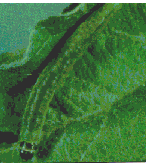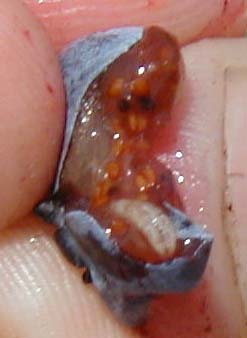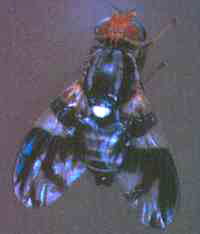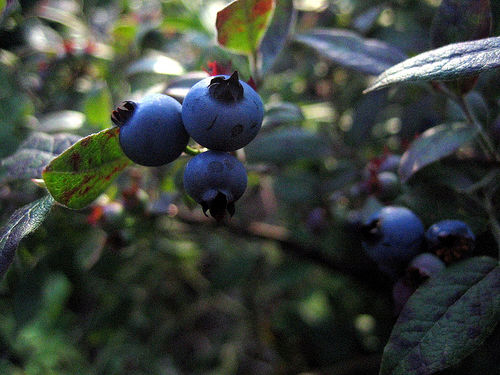Nutrition
V. angustifolium is a member of the plant kingdom so it produces its food through photosynthesis. Photosynthesis is a process that converts carbon dioxide into sugars using energy from the sun. The leaves of the V. angustifolium plant are the sites where photosynthesis takes place. Sugars are transported from the leaves to other parts of the plant through the vascular tissue called phloem. Sugars are stored in the plant in the form of starch.
A well developed root system is used to take up water and other nutrients from the soil. Water is then transported to other parts of the plant through the vascular tissue called xylem. Ericoid mycorrhizae also aid in an increased absorption of nutrients from the soil.
Like other plants, Vaccinium angustifolium has many insects that use it as a food source. The insect parasites that feed on blueberry plants are categorized into three main groups: foliage feeders, sap feeders, and fruit feeders. Foliage feeders feed on the foliage, buds, and flowers of the plant. Sap feeders use the plant's juices as a nutritional source. Fruit feeders eat the berries.
First, let's take a look at a foliage feeder:
Leafrollers: leaf rollers are the
larvae or caterpillars of some small moth species. These pests feed on
th e blossoms of the plant early in the growing season. When they are
full grown, they form a cocoon in a leaf shelter and undergo metamorphosis.
Adults emerge from the cocoon in one to two weeks. They mate and begin
the cycle all over again. Leafrollers do not cause significant loss to
the lowbush blueberry unless there are high numbers of them feeding on the
plant. To learn more about leafrollers and their life cycle, click
here.
e blossoms of the plant early in the growing season. When they are
full grown, they form a cocoon in a leaf shelter and undergo metamorphosis.
Adults emerge from the cocoon in one to two weeks. They mate and begin
the cycle all over again. Leafrollers do not cause significant loss to
the lowbush blueberry unless there are high numbers of them feeding on the
plant. To learn more about leafrollers and their life cycle, click
here.
Now an example of a sap feeder:
Aphids: Aphids are an insect that uses the sugary fluids of the plant as a nutritional source. They are tiny lice like insects that are only 1/16 inch long. They feed on the underside of the early leaves or on shoots of the plant. Aphids have a modified mouth called a stylet which they use to pierce the outter layer of the leaves or shoot. They then suck the sugar out of the vascular tissue called phloem which transports sugars throughout the plant. This is only a major problem when the plant is very young. Aphids are generally controlled by beetles and other natural enemies.
The final pests are the fruit feeders:
Blue berry maggot: The blueberry maggot
is the main pest among blueberry plants. Th
berry maggot: The blueberry maggot
is the main pest among blueberry plants. Th e adult flies lay their
eggs inside the berries of the plant. The small white maggot feeds on the
inside of the fruit. When the fruit falls to the ground, the maggot
enters the soil and completes its life cycle. The adult fly forms
underground and leaves the soil the next year. For more information on
the blueberry maggot, click
here.
e adult flies lay their
eggs inside the berries of the plant. The small white maggot feeds on the
inside of the fruit. When the fruit falls to the ground, the maggot
enters the soil and completes its life cycle. The adult fly forms
underground and leaves the soil the next year. For more information on
the blueberry maggot, click
here.
Note: the infested fruit is not harmful for human consumption, but as
expected, is considerably less appetizing as the picture above
demonstrates. Also, many companies have a zero tolerance for infected
fruit. Because of this, commercial blueberry growers almost always
have to use some type of insectide treatment on their plants.
Let's learn about the reproduction of lowbush blueberries.
